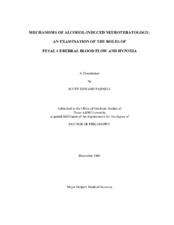| dc.description.abstract | Hypoxia (decreased tissue oxygen levels) has long been considered as a possible
mechanism of alcohol-induced developmental deficits, yet research has not conclusively
disproved this hypothesis, nor has it provided substantial evidence for a mechanism of
developmental alcohol insults involving hypoxia. Previous research has shown that
moderate acute doses of alcohol does not induce hypoxemia (decreased arterial oxygen
levels), yet these same studies have shown that this same alcohol exposure does
transiently decrease cerebral blood flow (CBF). This is significant because although
developmental alcohol exposure did not result in hypoxemia, the decreases in CBF seen
in these previous studies may induce hypoxia within the brain. Unfortunately, these
experiments were only performed after acute doses of alcohol, so it is unknown if a more
chronic or repeated alcohol exposure paradigm would have similar effects. The present
study examined blood flow in the sheep fetus after repeated alcohol exposure in a bingelike
paradigm throughout the third trimester. Additionally, this study examined the fetal
neurovascular response to a subsequent infusion of alcohol after the repeated alcohol
exposure. This latter experiment was designed to examine the hypothesis that alcohol
exposure throughout the third trimester affects the normal responsiveness of the
neurovasculature to alcohol (compared to previous research demonstrating acute
alcohol-induced decreases in CBF). The results from the present experiments indicate
that although few regions were significant, the majority of the regions (especially the
brain regions) exhibited a trend for increases in blood flows after alcohol exposure. This
phenomenon was especially prominent in the group receiving the lower dose of alcohol.
Additionally, the data from this study demonstrated that after repeated alcohol exposures
the near-term sheep fetus did not respond to a subsequent dose of alcohol in a similar
manner seen in previous experiments when the acute alcohol exposure was administered
in alcohol naïve animals. After the final alcohol exposure the subjects in this study had
either no effect in terms of blood flow or an increase in CBF. This is opposite to
previous observations which demonstrated reduced blood flow in numerous brain
regions. The present experiments suggest that alcohol does not induce fetal hypoxia, but
does negatively affect the normal neurovascular response to alcohol. This latter
phenomenon could have negative consequences on future development of the brain. | en |


